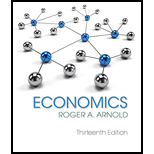
Economics (MindTap Course List)
13th Edition
ISBN: 9781337617383
Author: Roger A. Arnold
Publisher: Cengage Learning
expand_more
expand_more
format_list_bulleted
Question
Chapter 30, Problem 3WNG
To determine
Prove that, by selling and buying pollution permit can reduce half ton pollution.
Expert Solution & Answer
Want to see the full answer?
Check out a sample textbook solution
Students have asked these similar questions
Not use ai please
Hshshsheheheh
not use ai please
Chapter 30 Solutions
Economics (MindTap Course List)
Ch. 30.1 - Prob. 1STCh. 30.1 - Prob. 2STCh. 30.2 - Prob. 1STCh. 30.2 - Prob. 2STCh. 30.2 - Prob. 3STCh. 30.2 - Prob. 4STCh. 30.3 - Prob. 1STCh. 30.3 - Prob. 2STCh. 30.3 - Prob. 3STCh. 30.4 - Prob. 1ST
Ch. 30.4 - Prob. 2STCh. 30.4 - Prob. 3STCh. 30.5 - Prob. 1STCh. 30.5 - Prob. 2STCh. 30.5 - Prob. 3STCh. 30 - Prob. 1QPCh. 30 - Prob. 2QPCh. 30 - Prob. 3QPCh. 30 - Prob. 4QPCh. 30 - Prob. 5QPCh. 30 - Prob. 6QPCh. 30 - Prob. 7QPCh. 30 - Prob. 8QPCh. 30 - Prob. 9QPCh. 30 - Prob. 10QPCh. 30 - Prob. 11QPCh. 30 - Prob. 12QPCh. 30 - Economists sometimes shock noneconomists by...Ch. 30 - Prob. 14QPCh. 30 - Prob. 15QPCh. 30 - Prob. 1WNGCh. 30 - Prob. 2WNGCh. 30 - Prob. 3WNG
Knowledge Booster
Similar questions
- Answer question a, b, d, and earrow_forwardBzbsbsbdbdbdbdarrow_forwardRecent research indicates potential health benefits associated with coffee consumption, including a potential reduction in the incidence of liver disease. Simultaneously, new technology is being applied to coffee bean harvesting, leading to cost reductions in coffee production. How will these developmentsaffect the demand and supply of coffee? How will the equilibrium price and quantity of coffee change? Use both words and graphs to explain.arrow_forward
- Recent research indicates potential health benefits associated with coffee consumption, including a potential reduction in the incidence of liver disease. Simultaneously, new technology is being applied to coffee bean harvesting, leading to cost reductions in coffee production. How will these developmentsaffect the demand and supply of coffee? How will the equilibrium price and quantity of coffee change? Use both words and graphs to explain.arrow_forward► What are the 95% confidence intervals for the intercept and slope in this regression of college grade point average (GPA) on high school GPA? colGPA = 1.39 + .412 hsGPA (.33) (.094)arrow_forwardG Interpret the following estimated regression equations: wagehr = 0.5+ 2.5exper, where wagehr is the wage, measured in £/hour and exper is years of experience, colGPA = 1.39.412 hsGPA where colGPA is grade point average for a college student, and hsGPA is the grade point average they achieved in high school, cons 124.84 +0.853 inc where cons and inc are annual household consumption and income, both measured in dollars What is (i) the predicted hourly wage for someone with five years of experience? (ii) the predicted grade point average in college for a student whose grade point average in high school was 4.0, (iii) the predicted consumption when household income is $30000? =arrow_forward
- What are the key factors that influence the decline of traditional retail businesses in the digital economy? 2. How does consumer behavior impact the success or failure of legacy retail brands? 3. What role does technological innovation play in sustaining long-term competitiveness for retailers? 4. How can traditional retailers effectively adapt their business models to meet evolving market demands?arrow_forwardProblem 1.1 Cyber security is a very costly dimension of doing business for many retailers and their customers who use credit and debit cards. A recent data breach of U.S.-based Home Depot involved some 56 million cardholders. Just to investigate and cover the immediate direct costs of this identity theft amounted to an estimated $62,000,000, of which $27,000,000 was recovered by insurance company payments. This does not include indirect costs, such as, lost future business, costs to banks, and cost to replace cards. If a cyber security vendor had proposed 8 years before the breach that a $10,000,000 investment in a malware detection system could guard the company's computer and payment systems from such a breach, would it have kept up with the rate of inflation estimated at 4% per year?arrow_forwardNot use ai pleasearrow_forward
arrow_back_ios
SEE MORE QUESTIONS
arrow_forward_ios
Recommended textbooks for you
 Economics (MindTap Course List)EconomicsISBN:9781337617383Author:Roger A. ArnoldPublisher:Cengage Learning
Economics (MindTap Course List)EconomicsISBN:9781337617383Author:Roger A. ArnoldPublisher:Cengage Learning


 Microeconomics: Private and Public Choice (MindTa...EconomicsISBN:9781305506893Author:James D. Gwartney, Richard L. Stroup, Russell S. Sobel, David A. MacphersonPublisher:Cengage Learning
Microeconomics: Private and Public Choice (MindTa...EconomicsISBN:9781305506893Author:James D. Gwartney, Richard L. Stroup, Russell S. Sobel, David A. MacphersonPublisher:Cengage Learning Economics: Private and Public Choice (MindTap Cou...EconomicsISBN:9781305506725Author:James D. Gwartney, Richard L. Stroup, Russell S. Sobel, David A. MacphersonPublisher:Cengage Learning
Economics: Private and Public Choice (MindTap Cou...EconomicsISBN:9781305506725Author:James D. Gwartney, Richard L. Stroup, Russell S. Sobel, David A. MacphersonPublisher:Cengage Learning

Economics (MindTap Course List)
Economics
ISBN:9781337617383
Author:Roger A. Arnold
Publisher:Cengage Learning




Microeconomics: Private and Public Choice (MindTa...
Economics
ISBN:9781305506893
Author:James D. Gwartney, Richard L. Stroup, Russell S. Sobel, David A. Macpherson
Publisher:Cengage Learning

Economics: Private and Public Choice (MindTap Cou...
Economics
ISBN:9781305506725
Author:James D. Gwartney, Richard L. Stroup, Russell S. Sobel, David A. Macpherson
Publisher:Cengage Learning